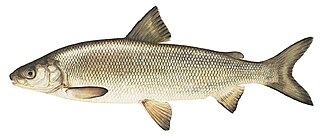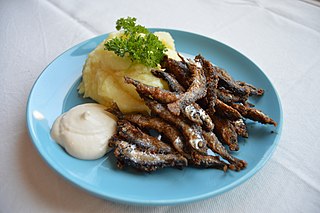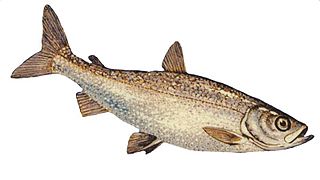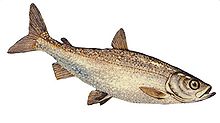
Coregonus is a diverse genus of fish in the salmon family (Salmonidae). The Coregonus species are known as whitefishes. The genus contains at least 68 described extant taxa, but the true number of species is a matter of debate. The type species of the genus is Coregonus lavaretus.

Salmonidae is a family of ray-finned fish that constitutes the only currently extant family in the order Salmoniformes, consisting of 11 extant genera and over 200 species collectively known as "salmonids" or "salmonoids". The family includes salmon, trout, char, graylings, freshwater whitefishes, taimens and lenoks, all coldwater mid-level predatory fish that inhabit the subarctic and cool temperate waters of the Northern Hemisphere. The Atlantic salmon, whose Latin name became that of its genus Salmo, is also the eponym of the family and order names.

Coregonus lavaretus is a species of freshwater whitefish, in the family Salmonidae. It is the type species of its genus Coregonus.

Stenodus leucichthys, also known as the inconnu, sheefish, ak balyk, or beloribitsa, is a species of large, anadromous, freshwater whitefish in the family Salmonidae. In the strict sense its natural distribution is restricted to the Caspian Sea basin. It is now considered extinct in the wild, but survives in cultured stocks. The nelma, a more widespread species of Eurasia and North America, is sometimes considered its subspecies.

The ciscoes are salmonid fish that differ from other members of the genus Coregonus in having upper and lower jaws of approximately equal length and high gill raker counts. These species have been the focus of much study recently, as researchers have sought to determine the relationships among species that appear to have evolved very recently. Cisco is also specifically used for the North American species Coregonus artedi, also known as lake herring.

The shortnose cisco is a North American freshwater whitefish in the salmon family Salmonidae. One of the members of the broader Coregonus artedi species complex of ciscoes, it is native to the Great Lakes of Canada and the United States. Its population has been declining and it has disappeared from some of its earlier haunts. The last reported population was restricted to Georgian Bay off Lake Huron in Canada. It is thought that declines in the population of this fish may be linked with the arrival of the sea lamprey, in the Great Lakes. The International Union for Conservation of Nature has rated the conservation status of this fish as "critically endangered", and possibly extinct.
Whitefish or white fish may refer to:

Coregonus albula, known as the vendace or as the European cisco, is a species of freshwater whitefish in the family Salmonidae. It is found in lakes in northern Europe, especially Finland, Latvia, Lithuania, Sweden, Russia and Estonia, and in some lakes of Norway, the United Kingdom, northern Germany, and Poland. It is also found in diluted brackish water in the Gulfs of Finland and Bothnia, both of which are in the Baltic Sea.

The round whitefish is a freshwater species of fish that is found in North American drainages from Alaska to New England, including the Great Lakes except for Lake Erie, and in Arctic tributaries of northeast Asia, as well as northern Kamchatka Peninsula and the northern coasts of the Sea of Okhotsk. It has an olive-brown back with light silvery sides and underside and its length is generally between 9 and 19 inches. They are bottom feeders, feeding mostly on invertebrates, such as crustaceans, insect larvae, and fish eggs. Some other fish species, like white sucker in turn eat their eggs. Lake trout, northern pike and burbot are natural predators. Other common names of the round whitefish are Menominee, pilot fish, frost fish, round-fish, and Menominee whitefish. The common name "round whitefish" is also sometimes used to describe Coregonus huntsmani, a salmonid more commonly known as the Atlantic whitefish.

Coregonus hoyi, also known as the bloater, is a species or form of freshwater whitefish in the family Salmonidae. It is a silvery-coloured herring-like fish, 25.5 centimetres (10.0 in) long. It is found in most of the Great Lakes and in Lake Nipigon, and inhabits underwater slopes. This fish is not to be confused with the extinct deepwater cisco, a large fish that shared a common name with the bloater.

The Atlantic whitefish is a coregonine fish inhabiting some freshwater lakes within Nova Scotia, Canada. It is known to survive only in the Petite Rivière watershed as landlocked populations. Earlier it was also found in the Tusket and Annis rivers of Nova Scotia. Those populations were anadromous, migrating to the estuary to feed while breeding in freshwater.
Stenodus is a genus of large-sized whitefish in the family Salmonidae. It consists of two species; one of them (beloribitsa) is extinct in the wild. The two species have alternatively been considered subspecies of the single species Stenodus leucichthys.

Coregonus artedi, commonly known as the cisco, is a North American species of freshwater whitefish in the family Salmonidae. The number of species and definition of species limits in North American ciscoes is a matter of debate. Accordingly, Coregonus artedi may refer either in a narrow sense to one of the several types of cisco found e.g. in the Great Lakes, or in a broad sense to the complex of all ciscoes in continental North American lakes, Coregonus artedi sensu lato.

The peled, also called the northern whitefish, is a species of freshwater whitefish in the family Salmonidae. It is found in northern Europe and Asia.

The pygmy whitefish is a freshwater whitefish of the genus Prosopium in the family Salmonidae. Found in the mountain streams and lakes in western North America, it also has isolated populations in Lake Superior and in Ekityki Lake, Chukchi Peninsula.

The Bering cisco or Lauretta whitefish is a freshwater whitefish found in Alaska and part of Russia. It is often considered to be the same species as the more common Arctic cisco.

Coregonus maraena, referred to in English as the maraene, maraena whitefish, vendace, cisco, lake herring, lake whitefish or the whitefish, is a whitefish of the family Salmonidae that occurs in the Baltic Sea basin – in the sea itself and the inflowing rivers, and in several lakes as landlocked populations. It is found in Denmark, Estonia, Finland, Germany, Latvia, Lithuania, Netherlands, Norway, Poland, Slovakia, Russia and Sweden. Up to 2023, it was listed as a vulnerable species by the IUCN, but this is now revised to Least Concern. It is listed as endangered by HELCOM. It is an extremely important fish within the Baltic Sea ecosystem, both for population equilibrium and for the local diets of the surrounding human population. Due to a variety of factors, mostly overfishing, the maraena's population dwindled to near-extinction levels. Thus, rampant repopulation was enacted to preserve this important fish.

The lake whitefish is a species of freshwater whitefish from North America. Lake whitefish are found throughout much of Canada and parts of the northern United States, including all of the Great Lakes. The lake whitefish is sometimes referred to as a "humpback" fish due to the small size of the head in relation to the length of the body. It is a valuable commercial fish, and also occasionally taken by sport fishermen. Smoked, refrigerated, vacuum-packed lake whitefish fillets are available in North American grocery stores. Other vernacular names used for this fish include Otsego bass, Sault whitefish, gizzard fish, common whitefish, eastern whitefish, Great Lakes whitefish, humpback whitefish, inland whitefish and whitefish.

The Peipsi whitefish is a freshwater whitefish of the family Salmonidae that naturally occurs in Lake Peipus on the border of Estonia and Russia, from where it also ascends to Lake Võrtsjärv to spawn. It has been introduced in Lake Burtnieks (Latvia), Gulf of Riga, many lakes of northern Russia, Poland, Germany, Netherlands, Japan, Lake Sevan (Armenia) and Balkash (Kazakhstan). It is a benthopelagic fish up to 60 cm long.
Coregonus tugun, the tugun, is a species freshwater whitefish from rivers draining to the Arctic Ocean. It is one of the several species of Siberian whitefishes, with a distribution encompassing rivers from the Ob in the west to the Yana River in the east. In the Lower Ob basin, it inhabits in all the Ural Mountains tributaries. It never enters the sea.
















